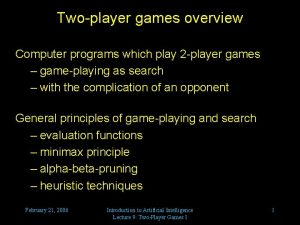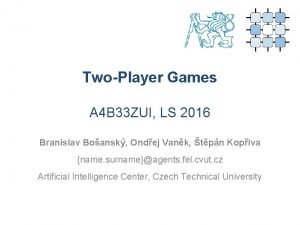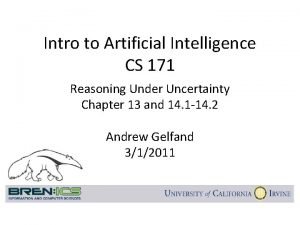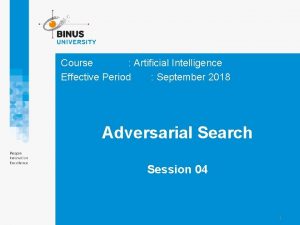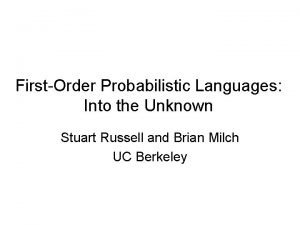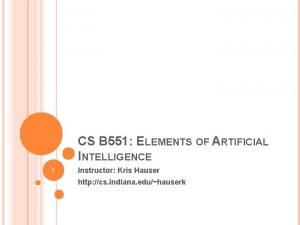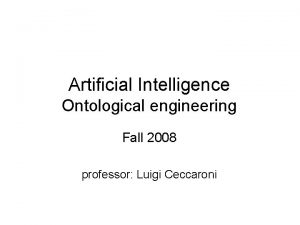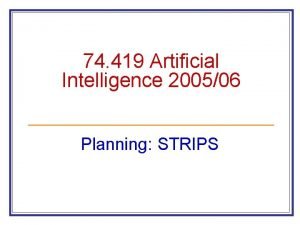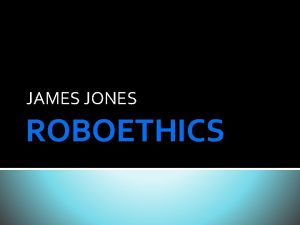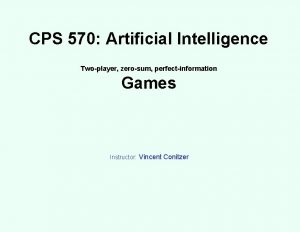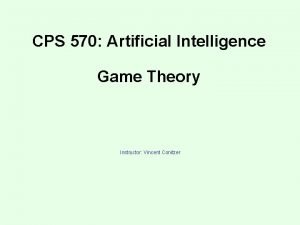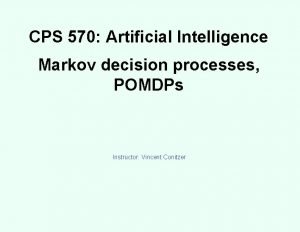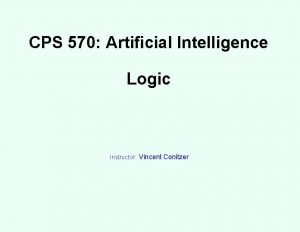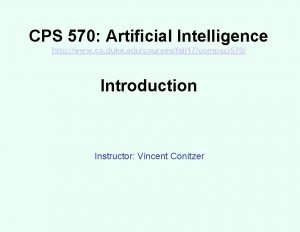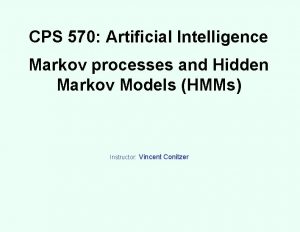CPS 570 Artificial Intelligence Twoplayer zerosum perfectinformation Games

























- Slides: 25

CPS 570: Artificial Intelligence Two-player, zero-sum, perfect-information Games Instructor: Vincent Conitzer

Game playing • Rich tradition of creating game-playing programs in AI • Many similarities to search • Most of the games studied – have two players, – are zero-sum: what one player wins, the other loses – have perfect information: the entire state of the game is known to both players at all times • E. g. , tic-tac-toe, checkers, chess, Go, backgammon, … • Will focus on these for now • Recently more interest in other games – Esp. games without perfect information; e. g. , poker • Need probability theory, game theory for such games

“Sum to 2” game • Player 1 moves, then player 2, finally player 1 again • Move = 0 or 1 • Player 1 wins if and only if all moves together sum to 2 Player 1 0 1 Player 2 0 1 Player 1 0 -1 Player 1 1 -1 1 0 Player 1 0 1 0 -1 1 0 1 1 1 Player 1’s utility is in the leaves; player 2’s utility is the negative of this -1

Backward induction (aka. minimax) • From leaves upward, analyze best decision for player at node, give node a value – Once we know values, easy to find optimal action (choose best value) 1 Player 1 0 Player 2 -1 0 -1 1 Player 1 -1 Player 2 1 0 Player 1 1 1 0 1 0 -1 1 Player 1 1 0 1 1 Player 1 1 -1

Modified game • From leaves upward, analyze best decision for player at node, give node a value 6 Player 1 0 Player 2 -1 0 -1 1 Player 1 -1 1 -2 Player 2 6 0 Player 1 1 1 0 6 4 0 1 0 -3 4 -5 7 Player 1 1 0 6 7 Player 1 1 -8

A recursive implementation • Value(state) • If state is terminal, return its value • If (player(state) = player 1) – v : = -infinity – For each action • v : = max(v, Value(successor(state, action))) – Return v • Else – v : = infinity – For each action • v : = min(v, Value(successor(state, action))) – Return v Space? Time?

Do we need to see all the leaves? • Do we need to see the value of the question mark here? Player 1 0 1 Player 2 0 1 Player 1 0 -1 Player 1 1 -2 1 0 Player 1 0 1 ? 4 0 1

Do we need to see all the leaves? • Do we need to see the values of the question marks here? Player 1 0 1 Player 2 0 1 Player 1 0 -1 Player 1 1 -2 1 0 Player 1 0 1 0 ? ? -5 1 0 6 7 1 -8

Alpha-beta pruning • Pruning = cutting off parts of the search tree (because you realize you don’t need to look at them) – When we considered A* we also pruned large parts of the search tree • Maintain alpha = value of the best option for player 1 along the path so far • Beta = value of the best option for player 2 along the path so far

Pruning on beta • Beta at node v is -1 • We know the value of node v is going to be at least 4, so the -1 route will be preferred • No need to explore this node further Player 1 0 1 Player 2 0 1 node v Player 1 0 -1 Player 1 1 -2 1 0 Player 1 0 1 ? 4 0 1

Pruning on alpha • Alpha at node w is 6 • We know the value of node w is going to be at most -1, so the 6 route will be preferred • No need to explore this node further Player 1 0 Player 2 1 Player 1 -1 Player 2 node w 0 0 1 Player 1 1 -2 1 0 Player 1 0 1 0 ? ? -5 1 0 6 7 1 -8

Modifying recursive implementation to do alpha-beta pruning • Value(state, alpha, beta) • If state is terminal, return its value • If (player(state) = player 1) – v : = -infinity – For each action • v : = max(v, Value(successor(state, action), alpha, beta)) • If v >= beta, return v • alpha : = max(alpha, v) – Return v • Else – v : = infinity – For each action • v : = min(v, Value(successor(state, action), alpha, beta)) • If v <= alpha, return v • beta : = min(beta, v) – Return v

Benefits of alpha-beta pruning • Without pruning, need to examine O(bm) nodes • With pruning, depends on which nodes we consider first • If we choose a random successor, need to examine O(b 3 m/4) nodes • If we manage to choose the best successor first, need to examine O(bm/2) nodes – Practical heuristics for choosing next successor to consider get quite close to this • Can effectively look twice as deep! – Difference between reasonable and expert play

Repeated states • As in search, multiple sequences of moves may lead to the same state • Again, can keep track of previously seen states (usually called a transposition table in this context) – May not want to keep track of all previously seen states…

Using evaluation functions • Most games are too big to solve even with alphabeta pruning • Solution: Only look ahead to limited depth (nonterminal nodes) • Evaluate nodes at depth cutoff by a heuristic (aka. evaluation function) • E. g. , chess: – Material value: queen worth 9 points, rook 5, bishop 3, knight 3, pawn 1 – Heuristic: difference between players’ material values

Chess example • Depth cutoff: 3 ply • White to move Ki – Ply = move by one player B p White R Rd 8+ … Black Kb 7 R p p White Rxf 8 Re 8 p K 2 -1 …

Chess (bad) example • Depth cutoff: 3 ply • White to move Ki B – Ply = move by one player R White p Rd 8+ … Black Kb 7 R p p White Rxf 8 Re 8 p K 2 … -1 Depth cutoff obscures fact that white R will be captured

Addressing this problem • Try to evaluate whether nodes are quiescent – Quiescent = evaluation function will not change rapidly in near future – Only apply evaluation function to quiescent nodes • If there is an “obvious” move at a state, apply it before applying evaluation function

Playing against suboptimal players • Minimax is optimal against other minimax players • What about against players that play in some other way?

Many-player, general-sum games of perfect information • Basic backward induction still works – No longer called minimax What if other players do not play this way? Player 1 0 1 Player 2 0 Player 3 0 (1, 2, 3) 1 (1, 2, 3) Player 3 1 0 (3, 4, 2) vector of numbers gives each player’s utility 1

Games with random moves by “Nature” • E. g. , games with dice (Nature chooses dice roll) • Backward induction still works… – Evaluation functions now need to be cardinally right (not just ordinally) – For two-player zero-sum games with random moves, can we generalize alpha-beta? How? Player 1 0 Nature 0 (1, 3) 50% (1, 3) Player 2 1 Nature (2, 3. 5) 50% Player 2 1 0 (3, 2) (3, 4) 60% 40% (3, 4) 1 (1, 2) Player 2 0 1

Games with imperfect information • Players cannot necessarily see the whole current state of the game – Card games • Ridiculously simple poker game: – Player 1 receives King (winning) or Jack (losing), – Player 1 can raise or check, “nature” 1 gets King – Player 2 can call or fold • Dashed lines indicate indistinguishable states 1 gets Jack player 1 check raise check player 2 call fold 2 1 call 1 fold call fold 1 1 1 -2 -1 • Backward induction does not work, need random strategies for optimality! (more later in course)

Intuition for need of random strategies • Suppose my strategy is “raise on King, check on Jack” – What will you do? “nature” 1 gets King – What is your expected utility? 1 gets Jack player 1 • What if my strategy is “always raise”? player 1 raise check player 2 • What if my strategy is “always raise when given King, 10% of the time raise when given Jack”? call fold 2 1 call 1 fold call fold 1 1 1 -2 -1

The state of the art for some games • Chess: – 1997: IBM Deep Blue defeats Kasparov – … there is still debate about whether computers are really better • Checkers: – Computer world champion since 1994 – … there was still debate about whether computers are really better… – until 2007: checkers solved optimally by computer • Go: – Branching factor really high, seemed out of reach for a while – Alpha. Go now appears superior to humans • Poker: – AI now defeating top human players in 2 -player (“heads-up”) games – 3+ player case much less well-understood

Is this of any value to society? • Some of the techniques developed for games have found applications in other domains – Especially “adversarial” settings • Real-world strategic situations are usually not two-player, perfect-information, zero-sum, … • But game theory does not need any of those • Example application: security scheduling at airports
 Twoplayer games
Twoplayer games Twoplayer games
Twoplayer games Twoplayer games
Twoplayer games Twoplayer games
Twoplayer games Optimal decisions in games in artificial intelligence
Optimal decisions in games in artificial intelligence Optimal decisions in games in artificial intelligence
Optimal decisions in games in artificial intelligence Artificial intelligence chapter 1
Artificial intelligence chapter 1 Fuzzy proposition
Fuzzy proposition Artificial intelligence the next digital frontier
Artificial intelligence the next digital frontier Artificial intelligence: a modern approach
Artificial intelligence: a modern approach Coordinated plan on ai
Coordinated plan on ai Csci-b 551 elements of artificial intelligence
Csci-b 551 elements of artificial intelligence Ontological engineering in artificial intelligence
Ontological engineering in artificial intelligence Ahead ea wall
Ahead ea wall Types of knowledge in artificial intelligence
Types of knowledge in artificial intelligence Rote learning in artificial intelligence
Rote learning in artificial intelligence Qualcomm smart audio 400 platform
Qualcomm smart audio 400 platform Artificial intelligence for class 6
Artificial intelligence for class 6 Strips planning example
Strips planning example Peas task environment
Peas task environment Conceptual graph in artificial intelligence tutorial
Conceptual graph in artificial intelligence tutorial Artificial intelligence applications institute
Artificial intelligence applications institute Ethics of artificial intelligence
Ethics of artificial intelligence References for artificial intelligence
References for artificial intelligence Cs 188
Cs 188 Artificial intelligence devices
Artificial intelligence devices
